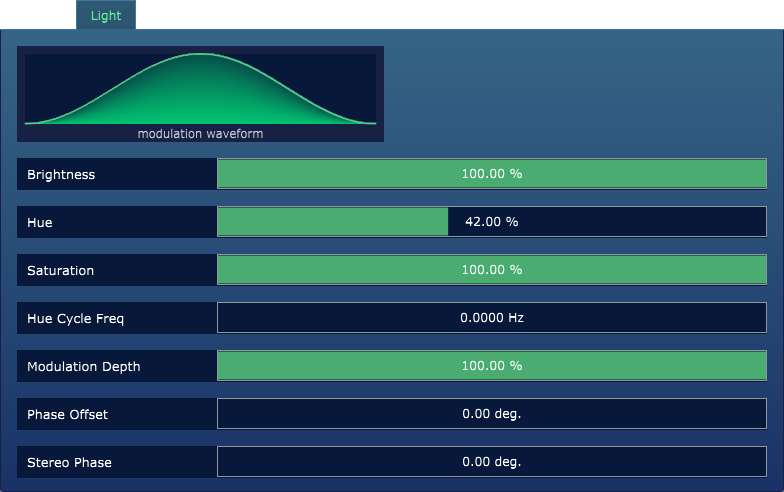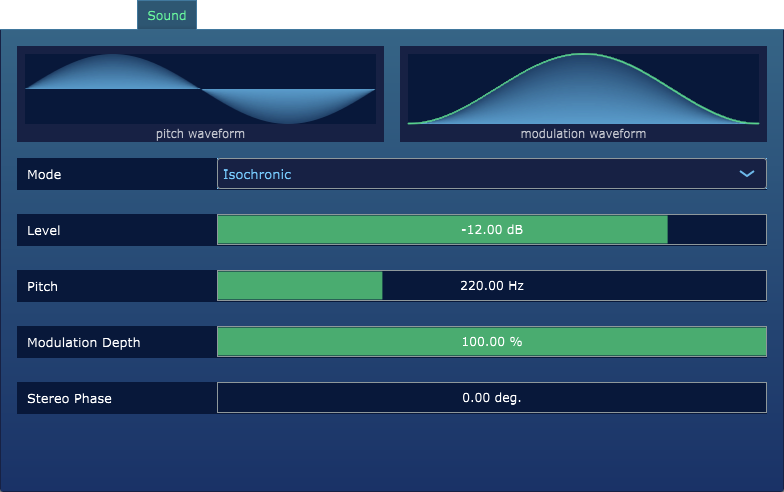Editor Overview
The Editor Screen houses the all editable Parameters with Prism (these are also exposed as Automation Parameters within the DAW). The example below has the Light tab selected, revealing all the editable parameters relevant to light output.

page break
Editor Basics
There are a couple of basic concepts which drive Parameter editing within Prism:
Waveform Selection
There are various sections within the Editor that provide a configurable Waveform (for either driving "Modulation" or "Pitch" for a particular set of parameters).

The Waveform can be changed by clicking on the image and selecting a different source Waveform.

Parameter Editing
Individual parameters all follow the same structure (with either a Slider or Dropdown for changing the Value):

Parameter NameDisplays the name of a given Parameter.Parameter ValueDisplays the value assigned to the Parameter. The value can be changed by click-and-dragging the mouse on the slider, or by clicking once on the slider and entering a specific value with the keyboard. Note: This value can also be driven by the related Automation Parameter within the DAW, which will be reflected here.
page break
Frequency Parameters
The Frequency tab houses all editable Parameters for controlling the modulation frequency for Light, Sound and Vibration within Prism. The Frequency value can be set manually, or controlled in relation to the DAW tempo.

FrequencyDrives the length of each Waveform cycle, from 0-60 Hz. This is the value utilized when the Sync Mode is set to "Off".Sync. ModeDrives the synchronization mode (Off,Divide Beat, orMultiply Beat). When in the Divide Beat or Multiply Beat modes, the Frequency parameter value is driven automatically by the result calculated via the Sync Ratio.Sync. RatioWhen Divide Beat or Multiply Beat sync mode is selected, this is the value by which the beat will be divided or multiplied, respectively. Note: For easily understandable calculations, it can be useful to use a tempo of 60 BPM or 120BPM within the DAW.

Note: When a Sync Mode other than "Off" is selected, the upper table displays the DAW's current Tempo (in this case 120 BPM),
as well as the resulting Sync Interval and Sync Frequency.
page break
Light Parameters
Brainwave Entrainment sessions that include light stimulus will modulate a light source at a desired entrainment frequency. The Light tab houses all editable Parameters related to the Light Waveform.
Light Output
This group of Parameters configures the basic settings for light color and waveform modulation.
By default the Hue/Saturation/Brightness mode (HSB) is enabled for color mixing, but you can change this to Red/Green/Blue (RGB) within the Color Mode dropdown in the Settings window.
The current mode for Light Encoding is also configurable via the plugin Settings window. This includes Lumasonic, SpectraStrobe, AudioStrobe, or Disabled (for audio-only use). By default, Lumasonic is used.
If you are working with Mindplace hardware (such as the Kasina), switch the encoding to SpectraStrobe.

BrightnessThe brightness level value for the Waveform.HueThe hue level value for the Waveform.SaturationThe saturation level value for the Waveform.Hue Cycle FreqThe frequency to cycle through the entire Hue range for the Waveform (this can be utilized for easy animation effects).Modulation DepthDrives the modulation mix for the waveform (0% for no modulation / solid color, 100% for full modulation, driven by Frequency).Phase OffsetOffsets the starting point of the Waveform (this is reflected in the Waveform Preview).Stereo PhaseDrives the Left/Right stereo phase separation (0-360 degrees).
Note: When configuring Prism for RGB light mixing within the Settings window, the Hue, Saturation, and Hue Cycle Freq parameters will be replaced with Red, Green, and Blue for color mixing. Prism will save these parameter values separately, so you can switch back and forth between modes and retain the last color set when you were working in a particular mode (see image below).

RedThe Red level value for the Waveform.GreenThe Green level value for the Waveform.BlueThe Blue level value for the Waveform.
page break
Sound Parameters
Brainwave Entrainment sessions that include audio stimulus will modulate an audio tone at a desired entrainment frequency. The Sound tab houses all editable Parameters related to the sound output for Prism, which can be configured for either Isochronic or Binaural tones with the following parameter:
ModeDrives the sound output mode (IsochronicorBinaural).
Isochronic
Isochronic uses an amplitude modulated pitch to create a rhythmic tone at the desired entrainment frequency.
For isochronic tones, the master Frequency parameter (from the Frequency tab) drives the beat, while all other aspects
of the tone are driven by the parameters below Mode.

LevelDrives the level of the tone output (in dB).PitchDrives the pitch for the source Pitch Waveform.Modulation DepthDrives the modulation mix for the Modulation Waveform.Stereo PhaseDrives the Left/Right stereo phase separation (0-360 degrees).
Binaural
Binaural uses two separate tones in each ear to create the perception of a modulated 3rd "beat frequency".
For binaural tones, the master Frequency parameter (from the Frequency tab) once again drives the desired entrainment frequency.
The Modulation Depth is replaced with Stereo Spread in this mode, and the Modulation Waveform is removed.
Stereo SpreadControls the stereo spread for the tone (0% for Monaural, 100% for Binaural).

page break
Vibration Parameters
Vibration can be used as an additional somatic entrainment source, and is intended to be used with transducers/subwoofers. Essentially, it is a low frequency Isochronic tone. The Vibration tab houses all editable Parameters related to the vibration channel output.

LevelDrives the level of the tone output (in dB).PitchDrives the pitch for the source Pitch Waveform.Modulation DepthDrives the modulation mix for the Modulation Waveform.Stereo PhaseDrives the Left/Right stereo phase separation (0-360 degrees).
page break
Aux Input Parameters
The Aux Input section houses all editable Parameters for utilizing an Audio Input channel (whether sourced from the microphone or another waveform sample playing) to further modulate the light and audio signals.

A preview of the real-time input level (in dB) is displayed in the input monitor at the top left, and the Peak level lines can be reset by clicking anywhere in the preview area.
Light GainGain multiplier applied to the aux. input, for the resulting output light signal.Light RMSAmount of RMS averaging applied to the aux. input, for the resulting output light signal.Light Mod. ModeConfigures light modulation source channels (Averaged MonoorStereo).Light Mod. DepthPercentage mix the aux. input levels have on the resulting light modulation.Audio Mod. DepthPercentage mix the Frequency modulation has on the output audio.Audio Stereo PhaseLeft/Right stereo phase separation (0-360 degrees) for the modulated audio source.Audio Output GainGain multiplier applied to the resulting modulated audio output.
